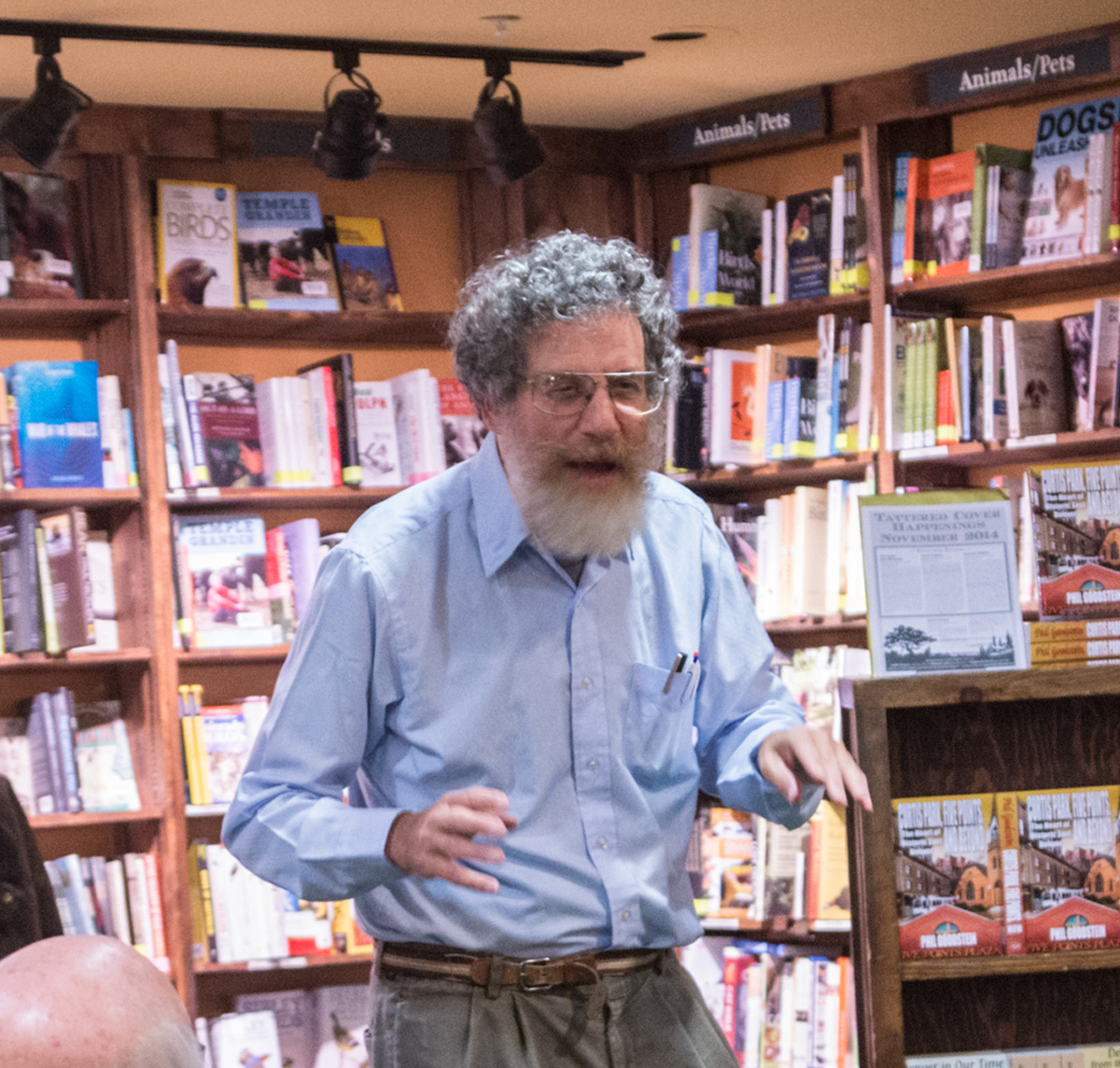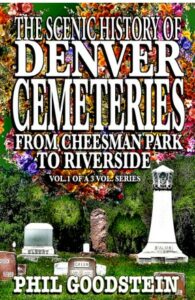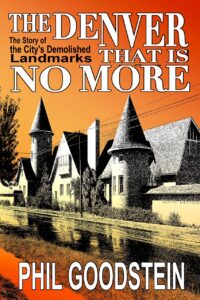
Phil Goodstein
303-333-1095
To get on the e-mail list please send your name to philgoodstein@gmail.com
Author Phil Goodstein is a Denver native who has churned out more than 20 volumes about the Mile High City. Not only has he seen to it that the volume is very well illustrated but, as is his wont, he emphasizes history from the bottom up. He explores controversies over the use of the Civic Center while emphasizing the way the different hopes and perspectives of various classes and economic interests have shaped the community. In a word, The Denver Civic Center is not just a history of the land in and around the Civic Center, but it is a profile of Denver as a whole. It is must reading for anybody seeking to grasp the nature of the Mile High City. Information about Goodstein’s books can be found below and at capitolhillbooks.com
March – May 2025
Talks and Tours by Phil Goodstein
Private tours are available. Books may be ordered from CapitolHillBooks.com, 303–837–0700 or bookelves@westsidebooks.com, 303–480–0220. Copies of Fairmount: Denver’s Ultimate Cemetery are available for $35.00, tax and post paid, from New Social Publications, Box 18026; Denver 80218.
Tuesday, March 11: How to Be a Tour Guide, 6:00 pm–8:00 pm
Phil Goodstein is ready to retire. He needs an apprentice/follower to take over his tours. Here he will discuss some of the basics of how to be a tour guide and what is expected from somebody giving history, haunted, and seamy tours of the city. Those interested in becoming guides will receive scripts for parts in experimental tours. The event is free. It meets at 1330 Monroe Street. (Monroe is four blocks west of Colorado Boulevard. This is a single-family house. Do not park in the adjacent parking lot.)
Sunday, March 16: Ghost Walk, 6:00 pm–8:00 pm
This is a free experimental tour of the walk featuring urban folklore, sex, sin, spooks, and scandal by the State Capitol. It will give those wanting to be tour guides a chance to read and tell stories. It gathers at the statue of the Indian on the east lawn of the Capitol along Grant Street between Colfax and 14th Avenue.
Monday, March 24: Seamy Side of Denver, 6:00 pm–8:00 pm
This is another free experimental stroll. It features lower downtown. Included are discussions of gambling, how bordellos worked, bloody murder, and a lot more. It will give those wanting to be tour guides a chance to read and tell stories. The event meets at the flagpole in front of Union Station at 17th and Wynkoop streets.
Saturday, March 29: Bicycle Tour of West Colfax Neighborhood, 11:00 pm–1:00 pm ***CANCELLED DUE TO WEATHER/RAIN***
Meet in front of Cheltenham School, 1580 Julian Street. The cost is $20 per person. (Julian Street is the “J” in the alphabet west of Federal Boulevard. The entrance of the school is between West Conejos Place [half-a-block north of West Colfax Avenue] and West 16th Avenue.)
Saturday, April 5: The Ghosts of Cheesman Park, 11:00 am–1:00 pm
Here is a third free walk for tour guide apprentices. The focus is on the haunted history of Cheesman Park and surrounding mansions. The meeting place is just west of the barricades on Ninth Avenue in Cheesman Park half a block to the west of Race Street, a road three blocks west of York Street.
Saturday, April 12: South of Botanic Gardens, 11:00 am–noon
Morgan’s Addition is the elite residential section directly to the south of Botanic Gardens. The walk gathers by the house at 801 Race Street, the northwestern corner of the intersection. It is a free walk sponsored by Realtor Jessica Abegg. Participants may tip the guide as they wish.
Saturday, April 19: Southern Globeville, noon–1:00 pm.
Gather in front of Garden Place School at the northwest corner of 44th Avenue and Lincoln Street. The easiest way to get there is to take Washington Street to 45th Avenue where there is a McDonald’s. Go five blocks west to Lincoln and one block to the south. This is also something of an experimental tour which may last from 12:45 to 1:15. Participants may tip the guide as they wish.
Monday, April 28: Seamy Side of Denver, 6:00 pm–8:00 pm
This is the regular Seamy tour. It meets at the flagpole in front of Union Station at 17th and Wynkoop streets. The cost is $20.00 per person.
Saturday, May 3: Denver History Night, 5:00 pm
This is a free, informal gathering to discuss Denver history, politics, and the meaning of life. It gathers at a pizzeria, Mici, 727 Colorado Boulevard.
Sunday, May 4: Emanuel Cemetery, 11:00 am–12:30 pm
Emanuel Cemetery is the Jewish section of Fairmount. Enter at the main gate to Fairmount at 430 South Quebec Street. Go through the main parking lot and up the hill by the Gothic Little Ivy Chapel. Just past it and the adjacent parking lot, turn right on the main road. Go about three blocks south to where there are benches and a sign on the right declaring “Emanuel Cemetery.” The walk will feature the older part of the cemetery. The cost is $20 per person.
Saturday, May 10: The Ghosts of Cheesman Park, 11:00 am–1:00 pm
Find out how Cheesman Park was once a cemetery and where sunken graves are visible. Learn about the Denver link to the horror classic The Changeling. Discover the stories of elite mansions west of the park, complete with the tales of some of their ghosts. The event gathers just west of the barricades on Ninth Avenue in Cheesman Park half a block to the west of Race Street, a road three blocks west of York Street. The cost is $20 per person.
Saturday, May 17: Ghost Walk, 7:00 pm–9:00 pm
Meet at the statue of the Indian on the east lawn of the Capitol along Grant Street between Colfax and 14th avenues. The cost is $20.00.
Please take a moment to check out Phil’s Newest Book Release and Upcoming Book Signings:
Where the Bodies are Buried!
Almost from the foundation of Denver, cemeteries have been part of the city. Their history is as checkered as that of themetropolis as a whole. The community’s first burial grounds, for example, became Cheesman Park, a place where upwards of 2,000 bodies remain.
Denver emerged at the time the romantic garden cemetery was a glowing ideal. A burial grounds was far more than a place for the dead, but a magnificent, well-landscaped park filled with imposing monuments. It was a park in its own right with magnificent trees where the living could commune with the deceased. Making this a Mile High realitywas a challenge given a lack of money and water to transform fields into lushly designed spots of eternal rest.
Click Here for Book Signings Info: The Scenic History of Denver Cemeteries, Vol. 1
Phil Goodstein, The Scenic History of Denver Cemeteries: From Cheesman Park to Riverside. Denver: New Social Publications, 2023. ISBN 978–0–9860748–7–5. vi + 240 pp. Illustrations. Index. $24.95
__________________________
Denver is always changing. This is a key point of a new, extremely well-illustrated history of the city, The Denver That Is No More by the city’s leading critic, Phil Goodstein. The highly entertaining, easy-to-read volume highlights the impressive buildings that were once the city’s point of pride, structures which have given way to the community’s questionable sense of “progress.”
From its beginnings during the Pikes Peak gold rush of 1858–59, Denver has had a split personality. Side-by-side with those who have called it their home, the community has attracted fly-by-night investors who have grabbed what they can from the Mile High City before moving on. In the process, in the hope of short-term profits, Denver has wantonly seen the destruction of distinguished buildings.
The Denver That Is No More takes the reader around the city. It highlights the continual transformation of the central business district. Readers are now on Colfax, learning about how the road was once a fine residential boulevard. Next the action is along South Colorado Boulevard, the place where baby-boomers went to play in the 1960s and 1970s. The book visits the old Elitch’s and enters some of the distinguished, but long-disappeared movie palaces. In the process, the study lives up to its claim that by grasping the Denver that is no more, readers can better understand the contemporary city and help plot its future.
Phil Goodstein, The Denver That Is No More: The Story of the City’s Demolished Landmarks. Denver: New Social Publications, 2021. ISBN 0–9860748–8–8/978–0–9860748–8–2. vi + 326 pp. Illustrations. Index. $24.95.
Here are some books Phil recommends for Troubled Times:
Flyer tours busing-1 (1)
The Denver School Book (Denver: New Social Publications, 2019. ISBN 0–9860748–4–5/978–0–9860748–4–4. vi + 490 pp. Illustrations. Index. $24.95) is Phil Goodstein’s latest venture.
It dissects what local schools have been all about. It starts with the city’s first school in 1859, telling about the character of teachers, administrators, and school board members. The study encompasses different schoolhouses, linking them with distinctive neighborhoods. The Denver School Book spells out how the schools have interrelated with the community, and their successes and failures. In passing, it deals with the essential nature of public education and refers to what critics have blasted as “compulsory miseducation.” The extremely well-illustrated Denver School Book is only the beginning of the story. It is the first of a trilogy. The tome ends in 1967, right when DPS was on the verge of school busing upheavals. They will be the subject of volume two, The Denver School Busing Wars. The third part of the study promises to bring the subject into the end of the second decade of the 21st century.
Phil Goodstein, The Denver Civic Center: The Heart of the Mile High City. Denver: New Social Publications, 2016. ISBN 0–9860748–2–9. vi + 478 pp. Illustrations. Index. $24.95.
One hundred years ago, Robert Speer triumphantly returned as mayor of Denver. A prime project was completing the Civic Center. This was an initiative Speer had launched on first taking office in 1904. In the middle of the city, he announced, Denver must have a majestic park. Adjacent to the Capitol, the Civic Center was to be the heart of the Mile High administration and civic life. He encountered numerous roadblocks in making it a reality.
By the time Speer became mayor, Denver had burgeoned as a metropolis with more than 100,000 residents. As it had boomed since the Pikes Peak Gold Rush of 1858–59, newly wealthy individuals advertised their affluence by erecting opulent mansions. Many were in and around what became the Civic Center.
Already in the 1860s, 14th Street had started to emerge as Denver’s address of distinction. Connecting the future Larimer Square with what became the Civic Center, it was where leading bankers, politicians, and members of high society lived. The original home of the University of Denver was at 14th and Arapahoe streets while many medical faceless were nearby. Included was an early home of the University of Colorado School of Medicine at 13th and Welton streets.
The Civic Center proper is in Evans Addition, land pre-empted by Colorado Governor John Evans in 1864 to the south of Colfax Avenue and west of Broadway. In passing, The Denver Civic Center explains why the diagonal street pattern of downtown ends at Colfax and who the street’s namesake, Schuyler Colfax, was.
Land usages rapidly changed during Denver’s first 50 years. As Capitol Hill overwhelmed Evans Addition and 14th Street in the early 20th century as the city’s elite neighborhood, the land near the Civic Center was increasingly an industrial and commercial district. Broadway north of Cherry Creek emerged as the city’s premier site to buy a prestigious new car. Numerous apartments and residential hotels filled the area.
All the while, the Capitol dominates the hill east of Broadway. Its construction and the various monuments in and about it, including in the Civic Center proper, are among the themes of the book. In passing, The Denver Civic Center tells about the tunnel system under the Capitol, complete with the folklore that a couple of floating heads are stashed beneath the seat of the state government.
In the 1970s, the area in and around the Civic Center started emerged as the Golden Triangle. This increasingly became the popular name for the spread encompassed by West Colfax Avenue, Speer Boulevard, and Broadway. Besides being the heart of Denver’s cultural district with the Denver Art Museum and the main branch of the Denver Public Library, it came to be the home of elite residential towers. In passing, the volume notes the Golden Triangle has also been the home of Denver television with the studios of channels 2, 4, 6, 7, 9, and 31 being in and around the section.
The Silver Triangle emerged in the early 1980s as a mirror of the Golden Triangle. Generally, this is the section bordered by West Colfax Avenue to Speer Boulevard to about Champa Street to 15th Street. The Denver Civic Center looks at the landmark buildings there, relating how the Colorado Convention Center emerged and contemporary efforts to transform 14th Street into Ambassador Street



